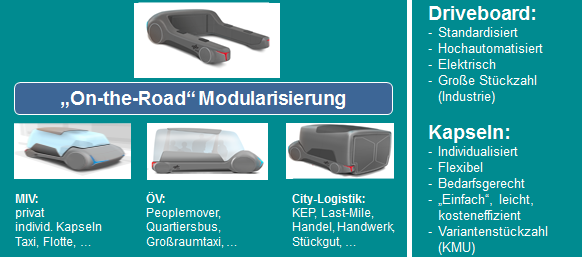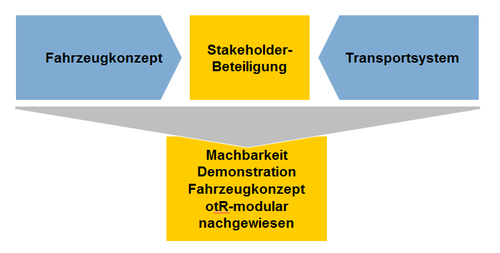ModECaP project
Feasibility study on disruptive vehicle concepts Modular Electrified Capsule and Platform (ModECaP)
Motivation
The mobility sector is undergoing major changes. The social demand for clean and sustainable mobility is increasing, supported by legal requirements for air pollution control. Cities are becoming key players in this process. Demographic trends and lifestyles, such as global population growth and urbanization, as well as individualization towards a single society, are just some of the trends that could further diversify mobility in the future and help new mobility concepts ("Mobility-as-a-Service / Pay-per-use") achieve a breakthrough.
In the coming years, the three technology trends of highly automated driving, electromobility and digitalization/connectivity will reinforce and accelerate each other. Together with the diversification of mobility, these technologies have the potential to permanently change the automotive business model. New product solutions, business models and (service) offerings are also being sought in order to counteract the lower added value of electric vehicles compared to conventional vehicles and thus the potential threat to job security. In particular, more and more disruptive solutions are being sought that support the necessary change much better than evolutionary developments in small steps. In this project, the feasibility of a disruptive vehicle concept consisting of a separation of driving module and transport capsule is being investigated.
Goals
Disruptive vehicle concepts are based on completely new technologies and innovations to replace or significantly change an existing product or service. Compared to the evolutionary further development of vehicles, disruptive vehicle concepts are characterized by features that appear unusual at first glance. The autonomous, driverless, electric vehicle concept envisaged in this project enables a new type of modularity and thus also a new intermodality, new products and business models. At its core, it consists of the separation of driving module and transport capsule as shown in Figure 1.

Figure 1 - Overview of the phases and activities of the CPS update process
The aim of this project is to prove the feasibility of a demonstration and industrialization project for the "on-the-road" modular, driverless vehicle concept:
- Detailing the overall vehicle concept and its architecture including making a 1:10 model;
- Identification of an economic use case for demonstration in the Stuttgart region;
- Stakeholder consultation from industry, business, research and society;
The ITIV focuses on the conceptual design of the E/E architecture required for the use cases under consideration and the feasibility of its realization within the disruptive vehicle concept.
Approach
The feasibility of a new mobility solution based on a disruptive vehicle concept essentially depends on two factors: a) the vehicle concept itself with all its new innovative features and b) the successful applicability in the transportation system with corresponding new business models. The stakeholders are at the center of this. On the vehicle concept side, these are the old and new vehicle manufacturers with suppliers at all levels and, on the transportation system and application side, the public transport operators, logistics companies, CEP service providers, local authorities and, not forgetting, the people as users. The following image illustrates these simple relationships:

Figure 2 - Procedure
Feasibility is given if the vehicle is technically feasible for all affected stakeholders and its application in the transportation system offers added value. This results in a simple procedure for the project: The vehicle concept under consideration and its application in the transportation system must be described and key data defined in an initial draft. For the vehicle concept, the overall vehicle with all interfaces, the drive board together with a new type of chassis, as well as the automation including ICT integration in the infrastructure are considered. On the application side in the transportation system, the two fields of passenger transport (OPNV - including individual transport) and freight transport (e.g. general cargo, commercial transport, etc.) are considered. In order to enable prompt technical implementation and application with industry and SMEs, potential partners are involved at an early stage in the central point of stakeholder participation.
Duration
01.09.2018 - 31.12.2019
Project partners
- German Aerospace Center (DLR) (Coordinator) - Institute of Vehicle Concepts (FK)
- Research Institute for Automotive Engineering and Vehicle Engines Stuttgart (FKFS)
- Karlsruhe Institute of Technology (KIT) - Institute for Information Processing Technology (ITIV)
- Karlsruhe Institute of Technology (KIT) - Institute for Automotive Systems Technology (FAST)
- University of Ulm (UULM) - Institute for Measurement, Control and Microtechnology (MRM)

